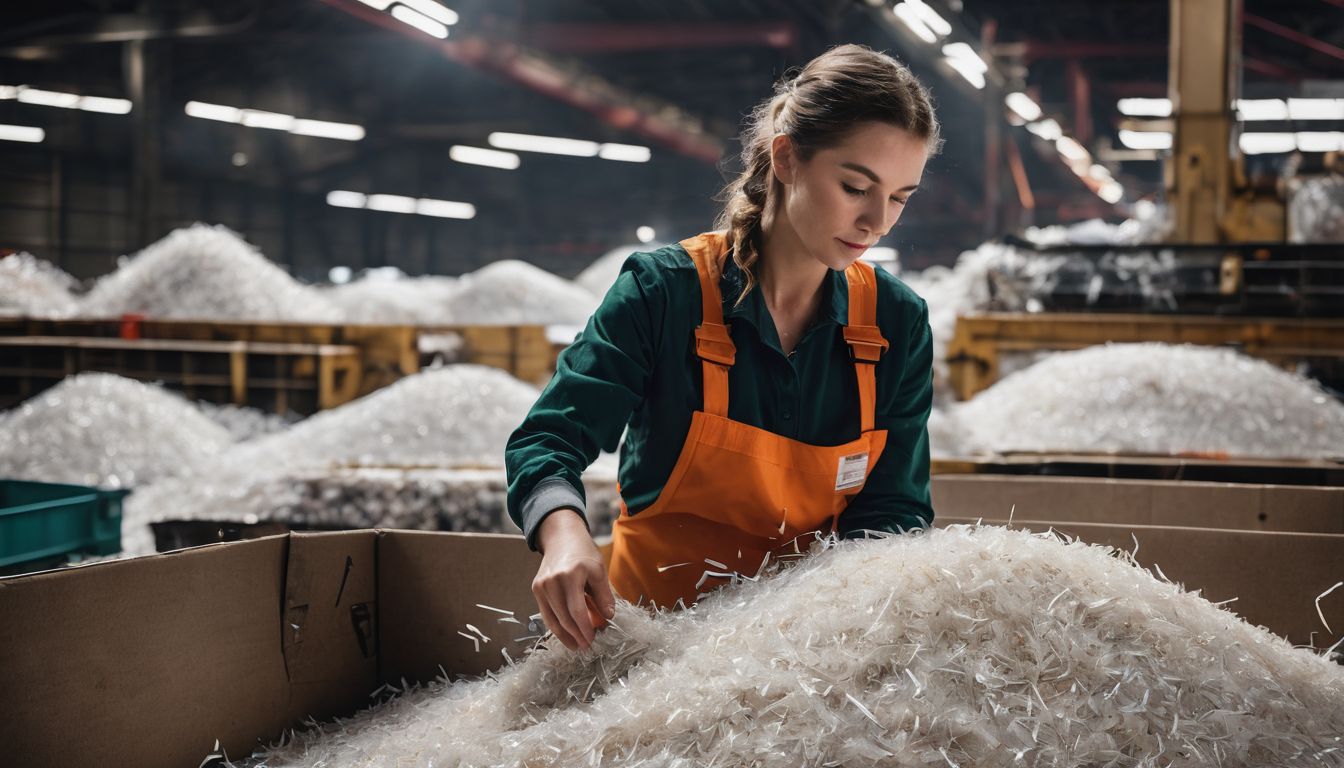What Is Acetate & How Is It Sustainable?
Ever wondered about the material behind your stylish sunglasses or favorite scarf? Meet acetate, a versatile substance derived from cellulose and wood pulp. This blog post dives into what acetate truly is, its uses, and most importantly, its sustainability profile.
Ready? Let’s unravel the truth behind acetate together!
What is Acetate?

Acetate is a type of synthetic fabric made from cellulose acetate, which is derived from natural materials such as cotton, hemp, bamboo, or wood.
Definition of acetate

Acetate is a kind of fabric. It’s not all natural, but not all man-made either. Scientists make acetate from wood pulp and other chemicals. This makes it a semi-synthetic material.
People often use this material in items like furniture, sunglasses, and more!
Common uses of acetate

Acetate finds its use in many everyday items we see or use. Here are some common uses of acetate:
- Acetate is used to make soft and smooth fabrics for clothes.
- It gives a shiny look to party – wear dresses.
- Many people use it in home goods like sofa covers and curtains.
- Sunglass makers like using acetate because it is strong.
- It helps make sturdy frames for eyeglasses too.
- You can find it in film and photography items.
- Some food packages have cellulose acetate in them.
The Sustainability of Acetate

Acetate production has a significant environmental impact and is not considered highly sustainable due to its reliance on artificial chemicals and energy-intensive processes. However, acetate can be biodegradable under certain conditions, and there are recycling options available for reducing waste in the fashion industry.
Environmental impact of acetate production

Making acetate can hurt the earth. It needs a lot of power and uses harsh chemicals. The making process is not very kind to our planet.
Trees give us the stuff to make acetate. But cutting down lots of trees is bad for our air and animals. Some factories try to be better by using less power or safer ways to get the tree parts they need.
Biodegradability of acetate

Acetate, the main component of acetate fabric, has a positive characteristic when it comes to sustainability – it can biodegrade. This means that over time, acetate can break down naturally into harmless substances.
However, it’s important to note that the overall manufacturing process of acetate may involve chemicals and energy-intensive processes that have environmental implications. So while cellulose acetate is biobased and biodegradable, its sustainability as a material depends on how it is sourced and produced.
Recycling options for acetate

Recycling options for acetate include:
- Mechanical recycling: Acetate can be mechanically recycled, where it is shredded into small pieces and then processed into new products.
- Chemical recycling: Through chemical processes, acetate can be broken down into its original components and used to create new materials.
- Upcycling: Acetate waste can be repurposed and transformed into new products with added value.
- Collaborative initiatives: Some companies have established programs to collect and recycle acetate products, reducing waste and promoting sustainability.
- Proper disposal: To ensure recyclability, it is important to dispose of acetate products in designated recycling bins or facilities.
The Pros and Cons of Acetate

Acetate offers several advantages, such as its affordability, versatility in terms of applications, and ability to mimic natural materials like cotton or silk. However, it also has disadvantages including its environmental impact during production and the challenge of recycling it effectively.
Advantages of acetate

Acetate has some advantages that make it a popular choice in various industries. Here are its key benefits:
- Versatility: Acetate is a thermoplastic material, meaning it can be melted and reshaped easily. This makes it highly versatile and suitable for different applications.
- Lightweight: Acetate is lightweight, which makes it comfortable to wear and convenient for various products like sunglasses and clothing items.
- Breathability: Acetate fabrics have good breathability, allowing air to pass through. This makes it a great option for summer clothing or upholstery.
- Softness: Acetate fabrics have a soft and smooth texture, making them comfortable against the skin.
- Dyeing capability: Acetate materials can be easily dyed with vibrant colors, allowing for creative designs in fashion and textile industries.
Disadvantages of acetate

Acetate has some disadvantages that we should be aware of. Here are some important points to consider:
- Manufacturing process: The production of acetate involves using artificial chemicals and energy-intensive processes, which can have a negative impact on the environment.
- Limited recycling options: While acetate is technically recyclable, the infrastructure for its proper recycling is limited compared to other materials like plastic or glass.
- Greenwashing potential: Some companies may claim their acetate products to be sustainable or eco-friendly without proper evidence or certification, leading to misleading marketing practices.
- Durability concerns: Acetate may not be as durable as other materials, making it more prone to wear and tear over time.
- Stain absorption: Acetate fabrics can absorb stains easily, making them more difficult to clean and maintain in the long run.
- Sensitivity to heat and sun exposure: Acetate can be sensitive to heat and prolonged sun exposure, which can cause it to shrink, fade, or become discolored.
- Chemical treatment required: The production of acetate typically involves treating cellulose with various chemicals, which raises concerns about potential chemical residue remaining in the final product.
- Limited availability of sustainable sources: While natural plant-based sources are used for cellulose acetate production, ensuring a consistent supply of sustainably sourced materials can still be challenging.
Sustainable Alternatives to Acetate

There are several sustainable alternatives to acetate, such as bio acetate materials made from renewable resources like cotton, hemp, bamboo, or wood.
Bio acetate materials

Bio acetate materials are a sustainable alternative to traditional acetate. These materials are made from renewable plant-based resources, such as cotton, hemp, bamboo, or wood pulp.
Unlike synthetic fabrics derived from petroleum, bio acetate is biodegradable and does not contribute to plastic pollution. It offers similar properties and versatility as regular acetate but with a lower environmental impact.
By choosing bio acetate materials, we can support the use of renewable resources and promote more eco-friendly practices in the textile industry.
Other eco-friendly fabric options

Eco-friendly fabric options are available as alternatives to acetate. These materials are more sustainable and have lower environmental impacts. Some of these options include:
- Cotton: Cotton is a natural material that is renewable and biodegradable. It can be grown without the use of harmful pesticides and chemicals.
- Hemp: Hemp is a highly sustainable plant that requires minimal water and no pesticides to grow. It can be used to make durable fabrics.
- Bamboo: Bamboo is a fast-growing plant that does not require much water or pesticides. It can be made into soft, breathable fabrics.
- Wood: Wood fibers can be used to make textiles that are renewable and biodegradable. They have a natural look and feel.
Conclusion: Making Informed Choices with Acetate

When it comes to acetate, understanding its sustainability is crucial. While acetate can come from renewable materials and be biodegradable, the manufacturing process may have environmental impacts.
It’s important to consider the specific sourcing and production methods when making choices about using or purchasing acetate products. By being informed, we can make more sustainable choices in the fashion industry and beyond.
FAQs
1. What is acetate made of?
Acetate is a type of plastic that is derived from cellulose, which is mainly found in plants and wood pulp.
2. Is acetate a sustainable material?
No, acetate is not considered a sustainable material as it is derived from non-renewable resources and requires extensive chemical processing to produce.
3. Can acetate be recycled?
Yes, acetate can be recycled, but the recycling process for this material can be challenging due to its composition and chemical properties.
4. Are there more sustainable alternatives to acetate?
Yes, there are more sustainable alternatives to acetate such as bio-based plastics or natural fibers like organic cotton or hemp that have minimal environmental impact compared to traditional acetate materials.







